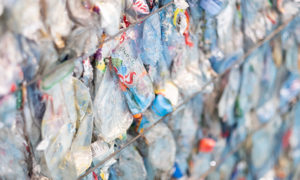The road map for a circular economy: key points to remember
A year after its launch, the ministry has produced a progress report on the road map for a circular economy (aka ‘FREC’). How do things stand exactly? And how might we expect this to translate in the bill still being drawn up?
In late April 2018, the government presented its road map for a circular economy. Its objectives: to reduce France’s resource consumption, halve the quantities of non-hazardous waste disposed of in landfills in 2025 compared to 2010, move towards 100% recycled plastics in 2025, reduce GHG emissions (including by means of saving an additional 8 mt of CO2 emissions each year through plastic recycling) and create 300,000 additional jobs. With these objectives in mind, fifty targets were set out in four major ‘chapters’: producing better (e.g. ecodesign, incorporation of raw materials into new products, etc.), consuming better (e.g. prolonging use, efficient functionalities, etc.), better waste management (e.g. recycling instructions, biowaste, textiles, etc.) and mobilising stakeholders (e.g. industrial and territorial ecology, public procurement, etc.).

Recovery instead of disposal
An economic and regulatory framework is needed, now more than ever, one which facilitates waste recovery instead of disposal. It is worth remembering that the objective of halving waste storage by 2025 involves redirecting 8 mt towards new recovery solutions. A decree simplifying regulations was passed in June 2018 and backed up by the ‘revenue’ section of the 2019 budget, which provided for tax reform to that end.
Several working groups launched
One of the working groups already launched – dedicated to tackling fly-tipping – is preparing a good practice guide for this summer. The group responsible for identifying solutions to improve construction waste collection and recycling should soon report its findings, as should the group responsible for preparing the repairability scores to be displayed on electrical and electronic products (see tackling planned obsolescence). Other groups should be launched in 2019, including one for biowaste (with separate collection planned for 2022) and one for issues involving changing job skill requirements.
Plastic, still a central concern
In July 2018, some 55 manufacturers and federations pledged to incorporate more recycled raw materials into their products. However, according to the Fnade, the pledge was for 275 kt (in addition to the current 300 kt), while France’s production of plastic waste is 3.5 mt. An order dated 4 January introduced a bonus designed to encourage the incorporation of recycled polyethylene plastic: companies that launch a product comprising 50% recycled PET will be eligible for a 50% discount on their eco-contribution for this product. Additionally, in February, NGOs and thirteen major signatory companies of the national pact on packaging with the Ministry for the Ecological and Inclusive Transition (MTES) pledged to reduce their use of plastic.
More generally, the ministry is involved in European projects, including the working group on banning oxo-degradable plastics, expanded polystyrene containers and plastic microbeads. It also proposed the creation of a European pact on plastic packaging.

New procedures in the future
A consultation has been launched to examine the implementation of new collection, reuse and recycling procedures for toys, sporting, DIY and gardening products. The idea of an EPR specific to the tobacco industry is under consideration, as is that of extending the packaging EPR procedure to manufacturing and sales packaging.
Also of note is the ongoing deployment of environmental labelling in five trial sectors (furniture, textiles, hospitality, electrical products and food products) and the work initiated with fast food companies with a view to complying with regulations on ‘five-flow’ recycling and food waste collection. The first labelling schemes for innovative, solidarity-based collection should have been trialled by summer.
A circular economy law before summer?
Work on the circular economy law is under way. A preliminary version that was ‘leaked’ in the specialist press in late January consisted of six articles. The first five were essentially about consumer information (see repairability, recyclability, recycling instructions, etc.), facilitating and reducing repair costs, improving consumption and tackling wastage in general – and food wastage in particular (e.g. advertising leaflets in mailboxes, textiles, etc.). Article 6 enabled Parliament to authorise the government to take measures to transpose the ‘waste’ directives and improve governance of EPR procedures, by means of an order. It also provided for reviewing part of the Environmental Code on waste, particularly to give greater consideration to re-use and repair.
This preliminary version left recycling professionals unconvinced and worried about major issues like the poor sales prospects of recycled raw materials, ceasing of import of some of these materials from China and lack of outlets for residual waste from businesses. As indicated during a dedicated conference at Pollutec 2018, there is still much to be done: improve prevention and sorting at the source, offer quality sorted materials to allow for the creation of proper manufacturing procedures, introduce a reduced general tax on polluting activities for residual fractions from certified efficient sorting/recycling/recovery facilities that achieve a minimum 50% recovery rate, establish a proper RDF procedure, not to mention the fundamental issue of managing construction and public works waste.
A NATIONAL RESOURCE PLAN
France relies almost exclusively on other countries for its metals and fossil fuels. Land losses limit its capacity to produce biomass each year. The national Resource Plan adopted in July offers a range of avenues for action to better align supply and demand of natural resources (e.g. minerals, land, and non-food biomass).
On the supply side, this involves for example developing recycling, deploying the national supply for resources available on French soil and reducing vulnerabilities associated with the changing import landscape. And on the demand side, this requires changing behaviours, optimising manufacturing processes and extending the life of equipment and products.